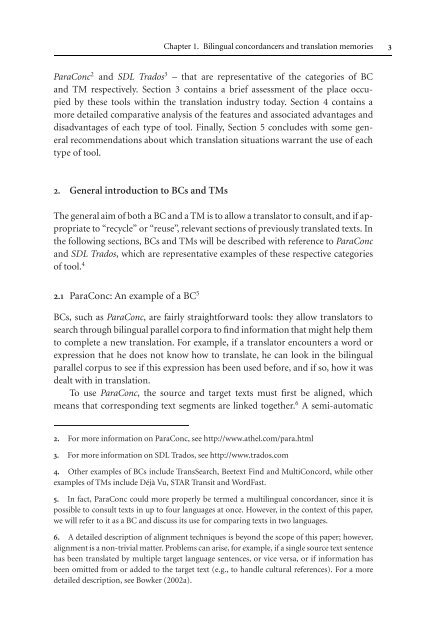Topics in Language Resources for Translation ... - ymerleksi - home
Topics in Language Resources for Translation ... - ymerleksi - home
Topics in Language Resources for Translation ... - ymerleksi - home
- No tags were found...
Create successful ePaper yourself
Turn your PDF publications into a flip-book with our unique Google optimized e-Paper software.
Chapter 1. Bil<strong>in</strong>gual concordancers and translation memories 3ParaConc 2 and SDL Trados 3 – that are representative of the categories of BCand TM respectively. Section 3 conta<strong>in</strong>s a brief assessment of the place occupiedby these tools with<strong>in</strong> the translation <strong>in</strong>dustry today. Section 4 conta<strong>in</strong>s amore detailed comparative analysis of the features and associated advantages anddisadvantagesofeachtypeoftool.F<strong>in</strong>ally,Section5concludeswithsomegeneralrecommendations about which translation situations warrant the use of eachtype of tool.2. General <strong>in</strong>troduction to BCs and TMsThe general aim of both a BC and a TM is to allow a translator to consult, and if appropriateto “recycle” or “reuse”, relevant sections of previously translated texts. Inthe follow<strong>in</strong>g sections, BCs and TMs will be described with reference to ParaConcand SDL Trados, which are representative examples of these respective categoriesof tool. 42.1 ParaConc: An example of a BC 5BCs, such as ParaConc, are fairly straight<strong>for</strong>ward tools: they allow translators tosearch through bil<strong>in</strong>gual parallel corpora to f<strong>in</strong>d <strong>in</strong><strong>for</strong>mation that might help themto complete a new translation. For example, if a translator encounters a word orexpression that he does not know how to translate, he can look <strong>in</strong> the bil<strong>in</strong>gualparallel corpus to see if this expression has been used be<strong>for</strong>e, and if so, how it wasdealt with <strong>in</strong> translation.To use ParaConc, the source and target texts must first be aligned, whichmeans that correspond<strong>in</strong>g text segments are l<strong>in</strong>ked together. 6 Asemi-automatic2. For more <strong>in</strong><strong>for</strong>mation on ParaConc, see http://www.athel.com/para.html3. For more <strong>in</strong><strong>for</strong>mation on SDL Trados, see http://www.trados.com4. Other examples of BCs <strong>in</strong>clude TransSearch, Beetext F<strong>in</strong>d and MultiConcord, while otherexamples of TMs <strong>in</strong>clude Déjà Vu, STAR Transit and WordFast.5. In fact, ParaConc could more properly be termed a multil<strong>in</strong>gual concordancer, s<strong>in</strong>ce it ispossible to consult texts <strong>in</strong> up to four languages at once. However, <strong>in</strong> the context of this paper,we will refer to it as a BC and discuss its use <strong>for</strong> compar<strong>in</strong>g texts <strong>in</strong> two languages.6. A detailed description of alignment techniques is beyond the scope of this paper; however,alignment is a non-trivial matter. Problems can arise, <strong>for</strong> example, if a s<strong>in</strong>gle source text sentencehas been translated by multiple target language sentences, or vice versa, or if <strong>in</strong><strong>for</strong>mation hasbeen omitted from or added to the target text (e.g., to handle cultural references). For a moredetailed description, see Bowker (2002a).
















